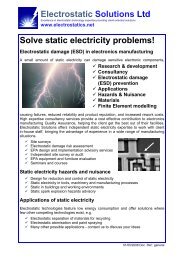Why should we worry about static electricity? - Electrostatic ...
Why should we worry about static electricity? - Electrostatic ...
Why should we worry about static electricity? - Electrostatic ...
Create successful ePaper yourself
Turn your PDF publications into a flip-book with our unique Google optimized e-Paper software.
Contact charging in processes<br />
• Charges are separated wherever two<br />
materials are in contact<br />
– Highly insulating liquids or solids encourage<br />
charge build-up<br />
• In pipes, containers or process equipment<br />
• Poured and blown powder particles can<br />
give high charge levels<br />
• A person walking or wiping a plastic<br />
equipment surface<br />
© Electro<strong>static</strong> Solutions Ltd 2 February 2006<br />
www.electro<strong>static</strong>s.net 19<br />
Rate of charge generation<br />
• Charge generation<br />
increases with<br />
– Area of contact<br />
– Rate of “breaking<br />
contact”<br />
For the polymer film passing<br />
over the roller, more charge will<br />
be generated as the roller speed<br />
is increased.<br />
– Rubbing action<br />
roller<br />
Polymer film<br />
© Electro<strong>static</strong> Solutions Ltd 2 February 2006<br />
www.electro<strong>static</strong>s.net 20<br />
Some processes generate high<br />
charge levels<br />
•Seiving<br />
•Pouring<br />
• Scroll feed transfer<br />
•Grinding<br />
•Micronising<br />
• Pneumatic conveying<br />
• Triboelectric powder coating<br />
© Electro<strong>static</strong> Solutions Ltd 2 February 2006<br />
www.electro<strong>static</strong>s.net 21



